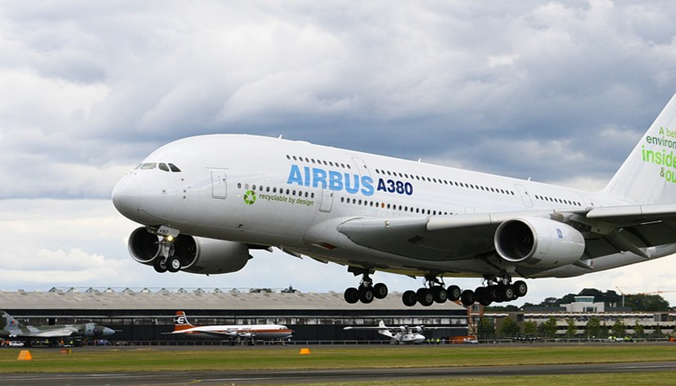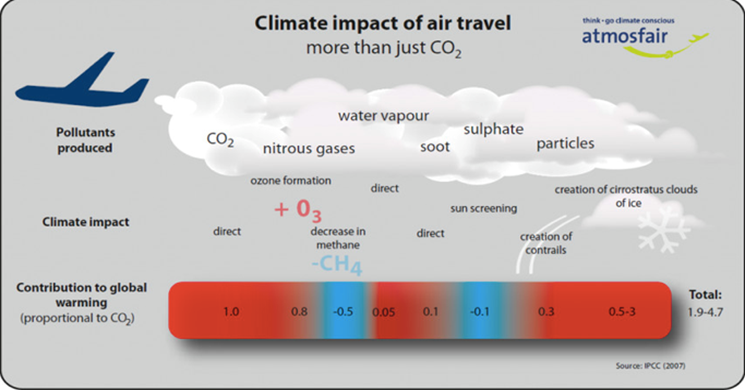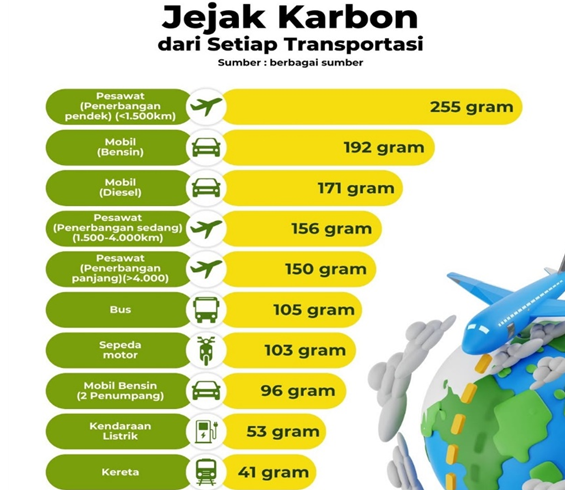
- Using avtur fuel or Aviation Turbine Fuel is made from a mixture of hydrocarbons produced from the petroleum refining process in a petroleum refinery unit called Kerosin.
- The 3 main factors that cause emissions in Airplanes are; Carbon dioxide, Condensation Marks and Altitude Factor & route.
- Aviation sector emissions are increasing faster than other modes of transport, and more than doubled between 1990 and 2019.
Airplanes Fuel
In addition to Greenhouse Gases (GHGs), emissions from transportation modes, which play a vital role and are increasing in use each year, also contribute to global warming.
Airplanes are one of the modes of transportation that use aviation turbine fuel (avtur), which is made from a mixture of hydrocarbons produced in the petroleum refining process at a refinery unit called kerosene. Avtur has special characteristics that distinguish it from fuels used in motor vehicles, such as gasoline and diesel.
In addition, avtur contains several additives, such as corrosion inhibitors, antioxidants, anti-foaming agents, antiknock agents, solvents, freeze point inhibitors, and static inhibitors.
The combustion process of avtur in an airplane’s engine produces chemical compounds that are released into the air during flight.

Airplane emissions consist of various substances that impact the environment, particularly in accelerating global warming. Carbon dioxide (CO₂) is the largest component of airplane emissions, making up about 70% of total exhaust gases. This gas accumulates in the atmosphere and significantly contributes to climate change. Additionally, nitrogen oxides (NOₓ) produced from airplane engines play a role in ozone formation at high altitudes, which can worsen air pollution and degrade atmospheric quality.
Besides NOₓ, sulfur dioxide (SO₂) released from airplane engines can cause acid rain and further deteriorate air quality. Water vapor (H₂O) generated from the combustion process also contributes to the formation of condensation trails, or contrails, which can lead to thin cloud formation and potentially enhance atmospheric warming.
In addition to gases, airplanes also produce soot particles, which are fine black carbon particles resulting from incomplete fuel combustion. These particles can persist in the atmosphere, contributing to air pollution and global climate change. With air traffic increasing each year, airplane emissions have become a major concern in efforts to reduce environmental impact and transition toward more sustainable energy sources.
Baca Juga
The Impact of Aircraft Emissions on Global Warming

1. Carbon Dioxide (CO₂) in Airplane Emissions
Aviation fuel combustion releases CO₂, which makes up about 70% of total exhaust gases. CO₂ has a long-term effect on the atmosphere: 30% dissipates within 30 years, 50% remains for centuries, and 20% persists for thousands of years. This accumulation of CO₂ is a major factor in global warming due to its ability to trap heat in the atmosphere.
2. Condensation Trails and Warming Effects
In addition to CO₂, jet engine combustion also produces water vapor, forming condensation trails (contrails) in the atmosphere. At high altitudes with freezing temperatures, this water vapor condenses into ice crystals, creating thin clouds known as cirrus. Persistent contrails in the atmosphere can enhance the greenhouse effect, contributing to global warming up to three times the direct impact of CO₂.
3. Altitude and Flight Route Factors
Around 90% of airplane emissions occur above 3,000 feet. However, aircraft operations on the ground and at low altitudes also contribute to air pollution, including nitrogen oxides (NOₓ), sulfur oxides (SO₂), hydrocarbons, and soot particles. Additionally, flight route changes that extend travel distances can increase fuel consumption and CO₂ emissions.
Baca Juga
How Significant Is Cloud Warming from Aviation?

Aviation sector emissions are increasing faster than other modes of transport, and more than doubled between 1990 and 2019. Aviation emissions increased from 1.5% of all European emissions in 1990 to 4.7% in 2019. According to the International Council on Clean Transport (ICCT), global CO2 from commercial aviation was 707 million tonnes in 2013. In 2019 the value reached 920 million tons, an increase of about 30% in 6 years. The United States, with the world’s largest commercial air traffic system, accounted for 200 million tons (23%) of total global CO2 in 2017. The EPA reports that commercial Airplanes and large business jets account for 10% of U.S. transportation emissions and account for 3% of the country’s total greenhouse gas production. Globally, aviation accounted for 2.4 percent of total CO2 emissions in 2018.
Jet fuel consumption produces CO2 at a specified ratio (3.16 kg) of CO2 / 1 kg of fuel consumed, regardless of the flight phase. Its long life in the atmosphere makes CO2 very potential as a greenhouse gas. Of the CO2 emitted in the air, 30% of the total gas is removed from the atmosphere organically over 30 years, an additional 50% is decomposed in a few hundred years, and the remaining 20% remains in the atmosphere for thousands of years.
#zonaebt #EBTHeroes #Sebarterbarukan
Editor : Alfidah Dara Mukti


